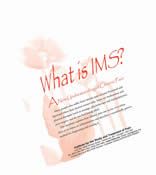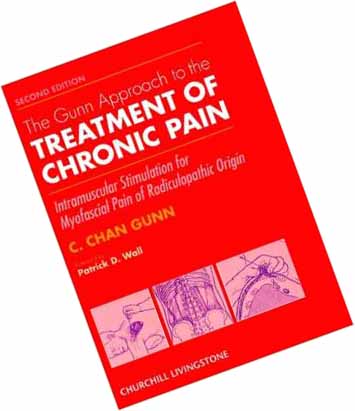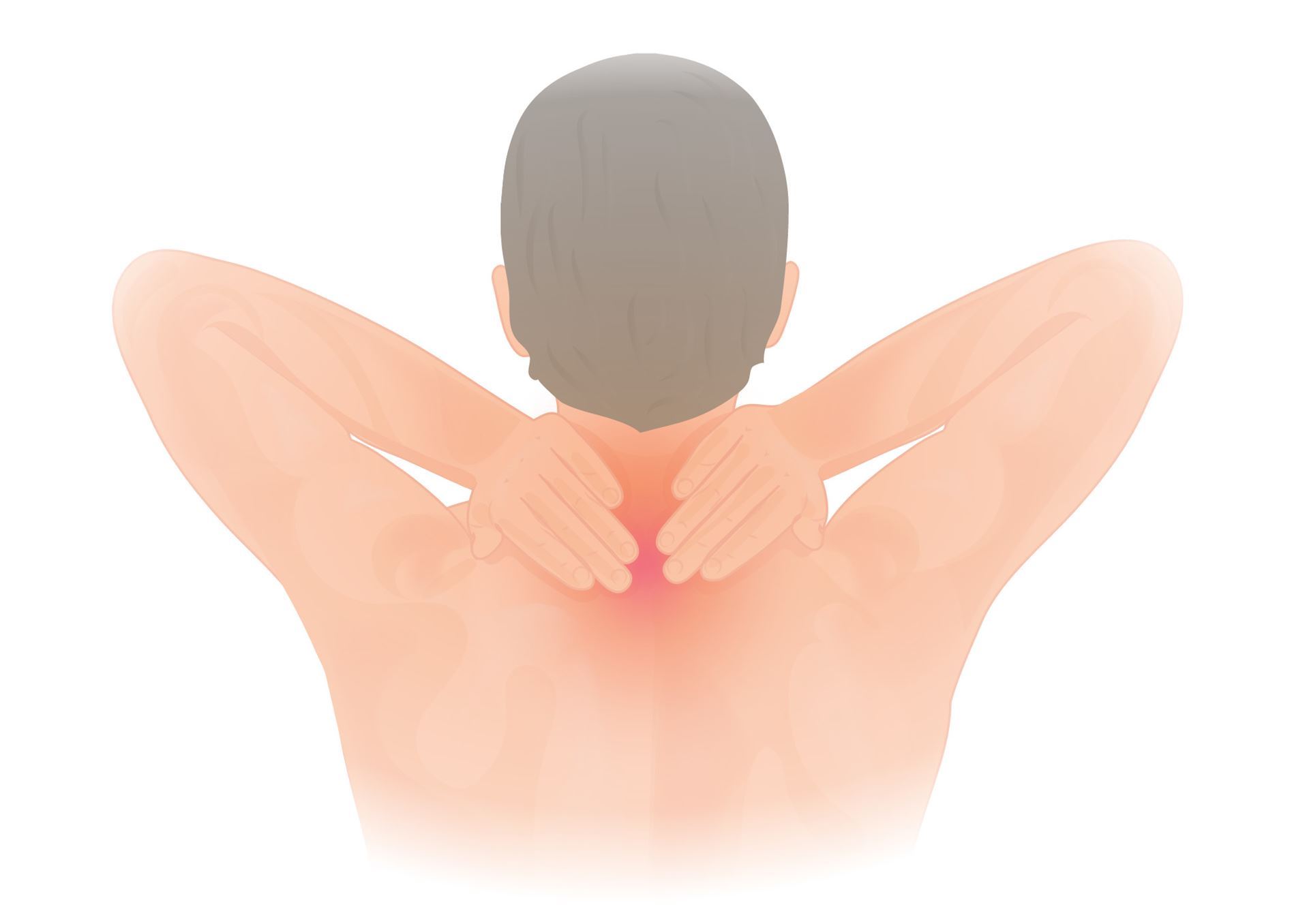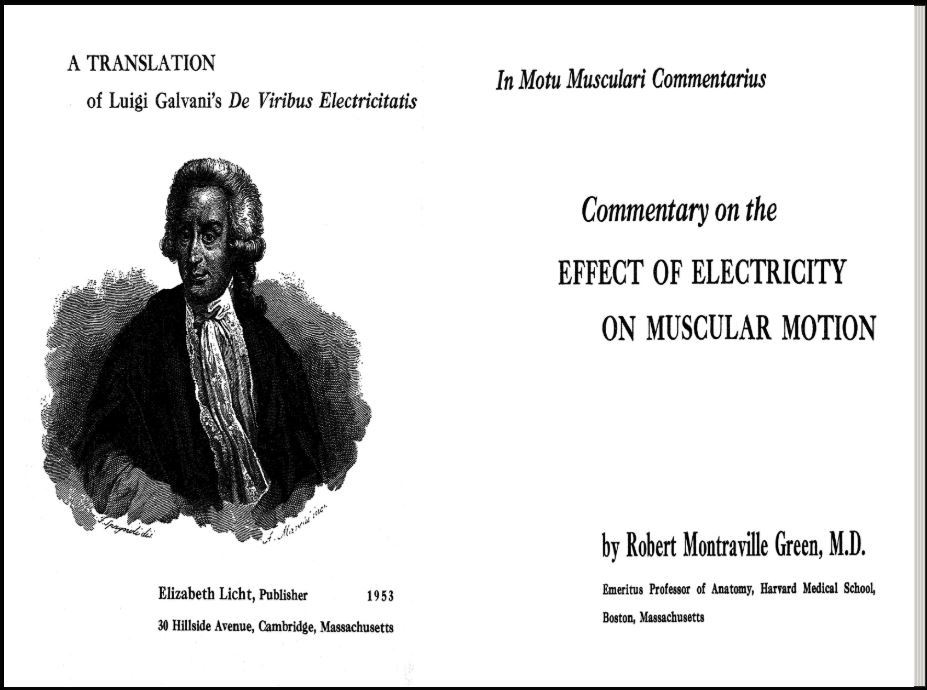-
-
-
-
-
-
-
-
Galvani Effect of Electricity on Muscular Motion
-
-
-
-
The Institute for the Study and Treatment of PainiSTOP's role is transitioning to UBC Gunn IMS Program – Faculty of Medicine https://www.gunnims.com/ |
If you are experiencing an URGENT Medical
Emergency
9-1-1 Telephone immediately 8-1-1 Nurse Hotline (if you are seeking Non-Urgent Medical Guidance) | T-9-1-1 Send a TEXT message if you are registered as part of the deaf, deafened, hard of hearing or speech impaired (DHHSI) community in Canada |
- Member Directory
- Published Works
- Featured Publications
- Galvani Effect of Electricity on Muscular Motion
Commentary on the Effect of Electricity on Muscular Motion
by Robert Montraville Green, MD
A Translation of Luigi Galvani's De Viribus Electricitatis
1953
This publication is cited in C Chan Gunn's articles
Soft Tissue pain: treatment with stimulation-produced analgesia - PDF
EXCERPT
Treatment of neuropathic pain - The Current of Injury
There is, serendipitously, an ideal source of energy - the body's own healing force - which can be tapped. Galvani, in a series of animal experiment that marked the beginning of electrophysiology, demonstrated in 1797 the existence of electricity in tissues. He was able to detect the electrical potential following tissue injury and called it the 'current of injury' (Galvani 1953). This intrinsic source of energy is the primary agent in promoting relief and healing. It is readily obtained, as in acupuncture and dry needling, by making minute injuries with a fine needle. Unlike extrinsic sources of energy, stimulation from the current of injury induced by the needle lasts for days until the miniature wounds heal. No injected medication is required.
Radiculopathic Pain: Diagnosis and Treatment of Segmental Irritation or Sensitization - PDF
EXCERPT
Unfortunately, all external forms of physical therapy have a critical drawback. They are passive, and when application is halted, stimulation ceases. Ideally, stimulation should use the body's own bio-energy, which can be recruited in the form of the "current of injury." Firsf described by Galvani in 1797, this current is generated when tissue is injured, for example, following injection or dry needling techniques including acupuncture. When the needle pierces muscle, it disrupts the cell membrane of individual muscle fibers, mechanically discharging a brief outburst of injury potentials referred to as "insertional activity.'' Injury potentials delivered on needle insertion are able to relax a shortened muscle instantly or within minutes. Needling also induces a sympatholytic effect that spreads throughout the body segment, releasing vasoconstriction. Pain in muscles, tendons and joints caused by excessive muscle tension is eased when the shortened muscles are relaxed. Subjective improvement [which can sometimes occur within minutes] can be confirmed objectively; for example, as an increase in joint range, or minor degrees of joint effusion may resolve and any decrease in muscle tenderness can be measured by the use of a pressure algometer. Endogenous opiates, now used to explain needling techniques, such as acupuncture, cannot account for all the observed effects.
Transcutaneous Neural Stimulation, Acupuncture and the Current of Injury - PDF
EXCERPT
Stimulation in transcutaneous neural stimulation is via intact skin using an exogenous source of current, whereas in acupuncture the current is endogenous, represented by the current of injury. The concept of muscle-generated electricity was first announced by Galvani over a hundred years ago and muscle potentials were recorded in 1826 and the injury current described in 1843. If a suitable galvanometer is connected to two electrodes. one applied to the intact surface of a nerve or muscle and the other to the cut or injured part of the same nerve or muscle, a deflection will result indicating that the injured part is negatively charged in relation to the intact surface. These electrical phenomena are known as demarcation currents or injury potentials.
Pain and Misperceptions in Neuropathways - PDF
EXCERPT
There is, however, one ideal source of energy. It is the body's own healing force which is easily tapped. Galvani, in a series of experiments which marked the beginning of electrophysiology, demonstrated in 1797 the existence of electricity in tissues. He was able to detect the electrical potential following injury and called it the ·current of Injury". This intrinsic source of energy, the primary agent in promoting relief and healing, is easily achieved by making minute injuries with a fine needle as in acupuncture. Unlike extrinsic sources of energy, the stimulation remains in effect for days, until the miniature wounds heal.
Neuropathic Pain: A New Theory of Chronic Pain of Intrinsic Origin - PDF
EXCERPT
"current of injury", first described by Galvani in 1797. This current is generated when tissue is damaged by injection techniques including acupuncture. Unlike external forms of stimulation, needle stimulation penetrates into muscle. Injury potentials that are discharged on needle insertion can relax muscle spasm instantly or within minutes. It also induces a sympatholytic effect that spreads throughout the body segment, releasing vasoconstriction. Pain in muscles, tendons and joints caused by muscle tension is eased when the shortened muscles are relaxed. Subjective and objective improvement (which can sometimes occur within minutes) can be confirmed, for example, by an increase in joint range, and minor degrees of joint effusion may resolve.
Acupuncture and the peripheral nervous system - PDF
EXCERPT
Needle injury also generates long-lasting currents that are involved in repair and regeneration. The current of injury, first described by Galvani in 1797, has been shown (using a vibrating probe that can measure steady extracellular currents as small as 0.1 μA/cm2) to generate up to 500 μA/cm2 ... Unlike externally applied, shortlived forms of stimulation like massage or heat, the current of injury can provide stimulation for several days until the miniature wounds heal. Stimulation by using the body's response to injury is an important resource, as desensitization of supersensitivity can take many days.
Motor Points and Motor Lines - PDF
EXCERPT
In normal muscle, electrical stimulation produces contraction indirectly via the nerve since muscle fibers themselves have a higher threshold to stimulation than intramuscular fibers. This effect is particularly manifest when stimulation occurs in a region of the muscle rich in nerve fibers - the transverse motor bond or zone of innervation. In a like manner. the skin site over the transverse motor band shows greater sensitivity to percutaneous stimulation (using a faradic current) with the terminal branches of the motor nerve in the muscle motor band nearer the skin surface accessible for stimulation. This surface area represents the motor point which is identified clinically as the site where a twitch may be evoked in response to minimal electrical stimulation. This transverse motor band of innervation is a fixed anatomic site - the skin overlying the motor point may be drawn aside, shifting the point which responds to the neurometer, but the transverse band of· innervation in muscle remains unaltered and may be confirmed by stimulation. Charts of the location of motor points (corresponding to Type I acupuncture points) were first made by the German neurologist Wilhelm Erb, and these points have been in use for many years to study intensity-duration curves and determine the extent of
denervation since a muscle deprived of its nerve supply responds via muscle fiber contraction at a higher threshold to galvanic current. Failure to find a motor point is in itself diagnostic of complete denervation of muscle. In a denervated muscle, instead of isolating the motor point, the examiner will find a fairly uniform but lower excitability over the entire muscle.

%20jpg.jpg)


